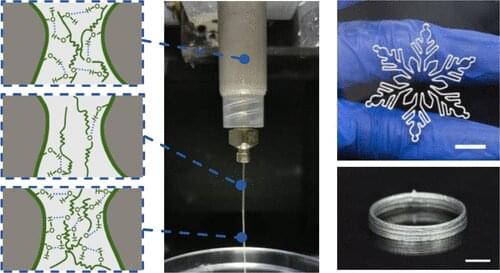In the future, smart clothing might monitor our posture, communicate with smartphones and manage our body temperature. But first, scientists need to find a way to cost-effectively print intricate, flexible and durable circuits onto a variety of fabrics. Now, researchers reporting in ACS Applied Materials & Interfaces have developed a conductive 3D printing ink made of liquid metal droplets coated with alginate, a polymer derived from algae.
Conventional electronics are rigid and unable to withstand the twisting and stretching motions that clothing undergoes during typical daily activities. Because of their fluid nature and excellent conductivity, gallium-based liquid metals (LMs) are promising materials for flexible electronics. However, LMs don’t stick well to fabrics, and their large surface tension causes them to ball up during 3D printing, rather than form continuous circuits. Yong He and colleagues wanted to develop a new type of conductive ink that could be 3D printed directly onto clothing in complex patterns.
To make their ink, the researchers mixed LM and alginate. Stirring the solution and removing the excess liquid resulted in LM microdroplets coated with an alginate microgel shell. The ink was very thick until it was squeezed through a nozzle for 3D printing, which broke hydrogen bonds in the microgel and made it more fluid. Once the ink reached the fabric surface, the hydrogen bonds reformed, causing the printed pattern to maintain its shape. The team 3D printed the new ink onto a variety of surfaces, including paper, polyester fabrics, nonwoven fabrics and acrylic-based tape. Although the printed patterns were not initially conductive, the researchers activated them by stretching, pressing or freezing, which ruptured the dried alginate networks to connect the LM microdroplets.
